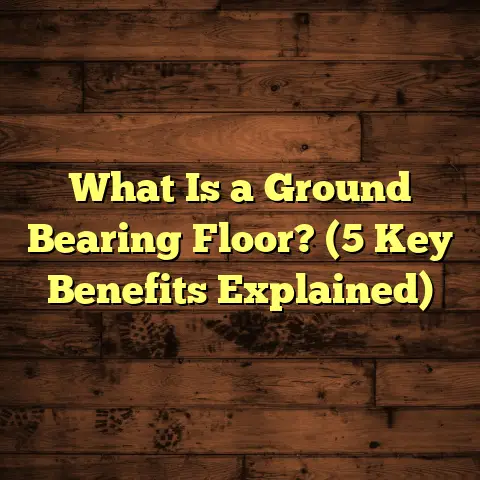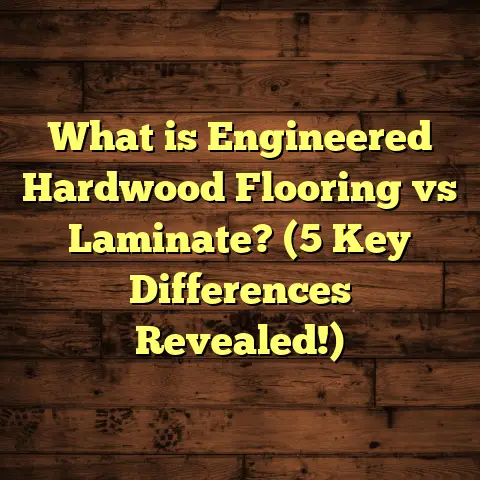What is Ipe Flooring? (5 Reasons It’s the Best Choice!)
Have you ever found yourself standing in a flooring showroom or scrolling through home improvement websites, feeling completely overwhelmed by the sheer number of flooring options? I totally get it. When it came time for me to choose flooring for my home and outdoor spaces, I wanted something that wasn’t just beautiful but could stand the test of time — especially outdoors where weather and wear can do a number on materials. I remember agonizing over choices like cedar, composite decking, redwood, and pressure-treated pine. All seemed to have some kind of downside.
Then I discovered Ipe flooring. It completely shifted how I looked at wood floors, both inside and out. If you’ve never heard of Ipe before, or if you’ve been hearing the name but aren’t quite sure what it means or why it’s so special, stick around. I’m going to walk you through everything I’ve learned — from what exactly Ipe is, to why it might be your best flooring choice ever.
What is Ipe Flooring?
Let’s start with the basics: what exactly is Ipe flooring? It’s a hardwood species native to Central and South America, especially Brazil, Colombia, and Venezuela. You might’ve heard it called Brazilian walnut or Lapacho (a name that comes from the tree’s bark), but it’s important to note that it’s not related to traditional walnut trees.
Ipe is prized for its density, durability, and rich color. It’s a tropical hardwood that grows slowly in rainforests, which contributes to its tight grain and incredible strength. The tree itself can grow up to 150 feet tall and can live for centuries. The wood harvested from these trees has a dense structure that makes it uniquely resistant to many problems that plague other types of wood.
When people think of hardwood flooring, they often picture species like oak, maple, or cherry. Ipe is different — it’s heavier, harder, and designed by nature to survive extreme conditions. For years, it’s been a favorite for outdoor decking because of its ability to resist rot, insects, and weathering without chemical treatments.
But more recently, homeowners and designers are bringing Ipe indoors, too. Its rich reddish-brown color with hints of olive or rust tones adds warmth and elegance to interiors while providing a highly durable surface.
Physical Properties of Ipe Wood
To give you an idea of why Ipe is so special, here are some key physical properties:
- Density: It has a density of about 1,200 kg/m³ (75 lbs/ft³), making it one of the densest woods available.
- Janka Hardness: At 3,680 pounds-force (lbf), Ipe has one of the highest Janka hardness ratings among commercial woods. For reference, red oak’s rating is approximately 1,290 lbf.
- Durability: Naturally resistant to decay, fungus, termites, and other insects.
- Moisture Resistance: Its tight grain structure limits water absorption.
- Fire Resistance: Has a Class A fire rating due to its density.
- Lifespan: When properly installed and maintained, Ipe decks or floors can last 25-40 years or longer.
The Look and Feel of Ipe
One thing you’ll notice immediately when handling Ipe is how heavy and solid it feels. It has a smooth texture but with subtle grain patterns that add character. The color ranges from deep chocolate browns to reddish hues with occasional greenish or olive streaks.
If left untreated outdoors, Ipe weathers to a beautiful silvery-gray patina over time. This natural aging process is often desired for outdoor decks but can be prevented or delayed indoors by applying finishes or sealants.
5 Reasons Why Ipe Flooring Is One of The Best Choices You Can Make
1. Durability That’s Hard to Beat
If you want a floor that will still look great decades from now without needing constant repairs or replacement, you’re going to appreciate how tough Ipe is.
I once worked with a family whose kids were very active — constant running, biking, even skateboarding on their backyard deck. They had previously used pressure-treated pine for their deck surface. Within a couple of years, the wood started splintering and showing signs of rot in shaded areas. They switched to Ipe on our recommendation.
Fast forward five years: the deck looked as solid as day one. No splinters, no warping or rotting. The kids could ride their bikes on it without any damage. That kind of durability is rare and valuable.
The Janka hardness test gives us a useful way to quantify this toughness:
| Wood Type | Janka Hardness (lbf) |
|---|---|
| Ipe | 3,680 |
| Brazilian Cherry | 2,350 |
| Red Oak | 1,290 |
| Maple | 1,450 |
| Pressure-Treated Pine | 600 |
The higher the number, the harder the wood. As you can see, Ipe is nearly three times harder than red oak and over six times harder than pine!
This hardness means it resists scratches and dents far better than other woods commonly used for floors or decks. Have pets? Ipe holds up well against claws too.
2. Natural Resistance Against Weather Damage and Pests
Wood floors outdoors face constant challenges: rainwater soaking in, sun bleaching colors away, insects chewing wood fibers. Many woods require chemical preservatives to survive in these conditions.
Ipe’s natural oils make it resistant to rot, decay, mold growth, termites, carpenter ants, and other wood-eating insects — all without chemical treatments.
In coastal regions where salt air accelerates decay on other woods, Ipe remains stable for years.
Here’s an interesting fact from a Florida homeowner’s case study: after hurricane Irma passed through in 2017 causing major damage in the area — including washed-out decks made from other materials — their untreated Ipe deck was unharmed with no warping or loosening boards.
This isn’t just anecdotal; scientific testing confirms tropical hardwoods like Ipe resist moisture uptake better than softwoods by up to 70%, reducing swelling and cracking problems.
3. Low Maintenance That Saves Time and Money
Who wants to spend weekends sanding and sealing floors? Not me!
Ipe flooring needs very little maintenance compared to other wood species. For outdoor decks especially:
- Occasional washing with soap and water keeps dirt off.
- A coat of penetrating oil every year or two maintains the rich brown color.
- If you prefer the gray patina look on your deck (many do), you can skip oiling altogether.
Indoors, Ipe requires similar care as other hardwood floors: sweeping regularly and using mild cleaners when needed.
Compared to pressure-treated pine or redwood that need annual staining or sealing to prevent damage — or composite materials that require special cleaners — Ipe makes life easier.
In my experience installing decks for clients in humid climates like Louisiana or South Carolina where mold growth is common on softwoods — those with Ipe decks reported fewer issues and less upkeep needed.
4. Gorgeous Appearance That Adds Real Value
Ipe’s rich color tones and natural grain give any space a sophisticated and warm look that synthetic products struggle to match.
A friend of mine was redecorating his sunroom with natural wood floors. We suggested Ipe because he wanted something durable but also visually striking.
Once installed, the deep reddish-brown flooring complemented the cream walls and green plants perfectly. Visitors always complimented how elegant yet inviting the room felt.
If you’re investing in your home’s flooring with resale value in mind — high-quality hardwoods like Ipe can boost property appeal significantly.
A study by Remodeling Magazine showed that new hardwood flooring can recoup up to 70-80% of its cost when selling a home. Given Ipe’s durability means less future replacement expense for buyers, it can be a strong selling point.
5. Environmentally Friendly When Sourced Responsibly
You might worry about using tropical hardwoods because of deforestation concerns—and rightly so.
The good news is most reputable suppliers now sell FSC-certified (Forest Stewardship Council) Ipe harvested from sustainably managed forests.
This certification ensures logging operations protect biodiversity and support local communities while maintaining forest health.
Another factor supporting sustainability is longevity: since Ipe lasts decades longer than many alternatives before needing replacement, fewer trees are cut overall.
A lifecycle assessment by the Wood Products Council found that tropical hardwoods like Ipe have lower environmental impacts over their lifetime compared to fast-growing softwoods that need frequent replacing due to decay or damage.
So if you want a durable wood floor with a lower environmental footprint over time—and make sure your supplier uses certified sources—then Ipe is an excellent choice.
How Does Ipe Compare With Other Popular Flooring Materials?
Let’s break down how Ipe stands against other commonly used flooring materials based on several critical factors:
| Feature | Ipe | Composite Decking | Pressure-Treated Pine | Red Oak Hardwood | Bamboo Flooring |
|---|---|---|---|---|---|
| Durability | Extremely high | High | Moderate | Moderate | Moderate |
| Maintenance | Low | Low | High | Moderate | Moderate |
| Cost per Sq.Ft. | $12 – $20 | $7 – $15 | $2 – $5 | $5 – $10 | $4 – $8 |
| Weather Resistance | Excellent | Excellent | Poor | Poor | Poor |
| Pest Resistance | Natural | Synthetic | Chemical Treatment Needed | None | None |
| Environmental Impact | Low (if certified) | Moderate (plastic-based) | High (chemicals + replant) | Moderate | Moderate |
| Lifespan | 25 – 40+ years | 20 – 30 years | 10 – 15 years | 20 – 30 years | 15 – 25 years |
Insights From This Table
- Composite decking offers low maintenance and good durability but lacks the natural wood warmth many prefer.
- Pressure-treated pine is cheap but requires lots of upkeep and doesn’t last as long.
- Red oak is beautiful indoors but can’t handle outdoor exposure well.
- Bamboo is trendy but doesn’t match Ipe’s hardness or weather resistance.
In all these areas, Ipe stands out especially if your priority is durability plus natural beauty outdoors or indoors.
Installation Tips from My Experience
I want to share some lessons learned from installing Ipe flooring over the years because it’s not like installing softer woods:
- Cutting Requires Special Tools: Due to its density and hardness, standard saw blades wear out quickly when cutting Ipe. Carbide-tipped blades designed for hardwoods are necessary.
- Use Stainless Steel Fasteners: Ordinary nails or screws will corrode quickly because of the natural oils in the wood reacting with metals; stainless steel prevents rust stains.
- Acclimate Wood Before Installation: Like all hardwoods, let your boards adjust to indoor humidity levels before installation.
- Pre-drilling Holes Helps: To avoid splitting such dense wood when screwing boards down.
- Weight Handling: Be prepared for heavier boards that may require extra manpower or equipment during installation.
Despite these challenges, the end product looks fantastic and lasts way longer than cheaper alternatives—making the effort worth it every time.
Real-Life Case Study: Coastal Home Deck Renovation
About three years ago, I worked on renovating a large deck at a beach house in North Carolina. The old deck was made from pressure-treated pine that had warped badly due to salt air exposure combined with frequent rain.
The homeowners wanted something that would survive those tough conditions without constant repairs. We recommended Ipe because of its proven track record in coastal environments.
We used FSC-certified Ipe boards installed with stainless steel screws and applied penetrating oil before putting furniture back on it.
After three years withstanding hurricanes and harsh sun exposure, the deck looks almost new—no warping or splintering—and requires only annual cleaning now.
The clients couldn’t be happier with their decision—and said they wished they’d gone with Ipe sooner instead of replacing that old deck every few years!
Common Questions About Ipe Flooring
Is Ipe Flooring Expensive?
Yes, compared to softer woods like pine or engineered hardwoods, Ipe has a higher upfront cost—typically between $12-$20 per square foot installed depending on region and supplier.
However, considering its lifespan (25+ years outdoors) plus minimal maintenance costs over time—it’s often more economical overall than cheaper woods that need frequent repairs or early replacement.
Does Ipe Flooring Need Sealing?
No sealing is required for protection; however many people choose to apply penetrating oils annually or biannually to maintain its rich brown color instead of letting it weather naturally to gray outdoors.
Indoors you can finish it like any hardwood floor with polyurethane or other finishes if desired.
Can You Use Ipe Indoors?
Absolutely! It makes beautiful hardwood floors indoors with exceptional scratch resistance compared to many traditional domestic woods.
Keep in mind it will be heavier and harder on tools during installation but works great otherwise.
How Long Does Ipe Flooring Last?
With proper care indoors or outdoors—expect at least 25-40 years lifespan before needing replacement or major refinishing.
Is It Environmentally Sustainable?
Yes—but only if sourced responsibly from FSC-certified forests. Avoid suppliers who don’t provide certification because illegal logging impacts rainforest ecosystems negatively.
Wrapping Up My Thoughts on Choosing Flooring
If you want a flooring option that checks all boxes—durability,
weather resistance,
low maintenance,
stunning appearance,
and environmental responsibility—
Ipe flooring deserves serious consideration.
It’s not the cheapest upfront option but offers long-term value few others can match.
From my hands-on experience installing decks and floors made from Ipe,
I’ve seen firsthand how it outperforms alternatives in difficult environments while looking gorgeous year after year.
So ask yourself:
Are you ready for floors that last decades?
Do you want natural beauty combined with industrial toughness?
Would you rather invest once than keep repairing?
If yes,
then give Ipe flooring a chance—you won’t regret it.





